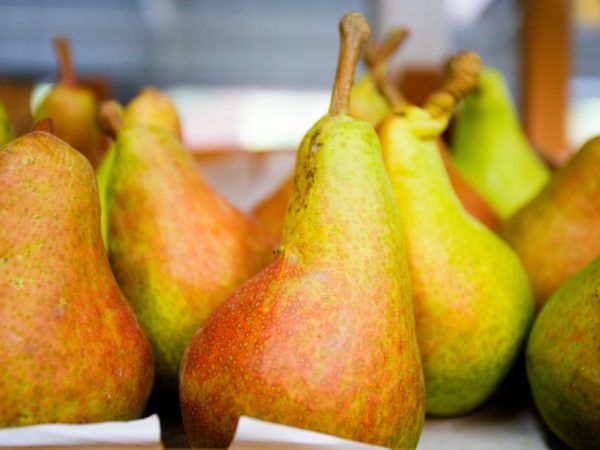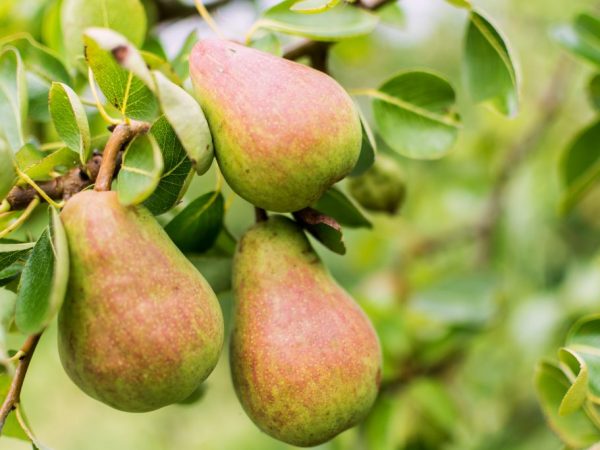Description of Valentine pear
To grow a pear tree and enjoy tasty and healthy fruits, you need to choose a suitable variety. It must be hardy, self-fertile, tolerate most diseases and give a high yield. The Valentine's pear has such qualities.

Description of Valentine pear
Pear characteristics
Thanks to the Ural agronomists, the Valentin variety was bred. It is obtained with the help of a large number of hybrid pear species, which always give a juicy and high-quality harvest, even in the most unfavorable conditions.
The Valentine pear variety is fruit, summer ripening. The height of the tree is 3 m. It has many branches and a lush crown. The foliage of the tree is large, acute-oval in shape. During the growing season, white flowers appear, medium in size with a slight aroma. Flowering begins in May and June.
According to the description, the pears are yellow in color with a pink blush. Weight 110-140 g. It is juicy with tender pulp, does not have granules inside.
If the summer is hot, the harvest is harvested in mid-August, and in the cold period in September. The fruit is hardy. Begins to bear fruit at 4-5 years of age.
Landing features
Planting pear seedlings is no different from planting other varieties. It is better to plant on a hill so that the roots do not rot and the tree does not die.
Site selection and soil preparation
The soil should be loose - it will drive air and moisture well. It is worth adding a little clay to retain moisture near the roots.
The site is selected south or southwest. It should be well lit, but not sultry. Due to the special root system, the plant treats moisture well, but if the air is too humid, it begins to weaken.
Planting a plant
Preparation for landing consists of the following steps:
- a hole is dug in the parameters of 60x100 cm;
- the outer layer of the earth is the most fertile: humus, peat, ash, superphosphate, potassium salt, lime and fluff (2-3 buckets of each substance) are added to it, all components are mixed well and applied;
- they take a peg and drive it into the center of the pit, and form the ground around it in the form of a hill - put a seedling on its very top, carefully spread the roots and sprinkle it with the rest of the earth: it is necessary to control the depth of planting, the roots should be above the ground level;
- it is recommended to irrigate the plant with water in 3 buckets, regardless of weather conditions;
- when the soil near the plant dries up, the seedling is attached to the peg, and the earth is mulched with humus or needles.
Care rules

Properly caring for the tree will have a good harvest.
After planting, the tree needs to be provided with care that will help it grow and develop in the first year of life.
Mulching
It is prohibited to pollute the tree trunk circle. It must be kept clean, mulched or loose. Mulch is able to protect the root system from dryness, from the appearance of weeds, controls soil moisture, protects the tree from stress and sudden changes in temperature.
Watering
The pear loves moisture, so it should be watered periodically. The plant must be well watered before and after flowering, after the fruit appears.
The correct irrigation option is sprinkling, that is, imitation of precipitation. This procedure is important, especially in hot summer. If it rains frequently, then watering can be completely canceled.
Top dressing
The number of dressings is selected based on the state of the plant, soil fertility and individual developmental characteristics. They begin to fertilize, focusing on the length of the growth. For an adult tree, the norm is annual shoots 40 cm in size, if the size is smaller, then fertilizer must be applied.
Top dressing is introduced in the second year of life. This is done in spring and autumn, it is recommended to make several dressings in the summer. Fertilizers in the form of organic matter are added every 3 years, but mineral fertilizers are added every year. It is recommended to build a trench near the tree. Its length depends on the number of fertilizers that will be applied. 9 kg of humus, 25 g of potassium chloride and 15 g of urea are usually taken per m2. First, phosphorus-potassium fertilizers are added to the prepared trench, and only then organic.
Pruning
After planting, it is better not to circumcise, this will ruin survival and development. The procedure is carried out in the second year after planting, so that ripe fruits receive more nutrients.
The procedure is carried out in several stages:
- crown formation;
- removal of dried branches before the beginning of the growing season;
- the main pruning is carried out in early March-April: most of the branches are removed so that they are not loaded with fruits.
Diseases and pests
The description indicates that the variety has a weak immunity, often sick with scab. To combat the disease, it is advisable to use the drugs Merpan, Horus.
The plant is attacked by leaf gall midge. You can get rid of it manually by collecting and destroying the nests of the parasite. Prevention is insecticide treatment.
Conclusion
Valentine's pear grows in cold regions, pleases gardeners with a high and high-quality harvest. If you take into account the moments of caring for the plant, you will carry out preventive measures, she will thank you with sweet and juicy fruits.


